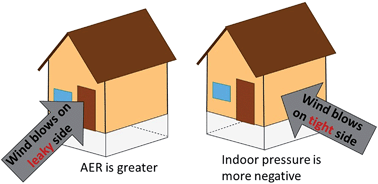当前位置:
X-MOL 学术
›
Environ. Sci.: Processes Impacts
›
论文详情
Our official English website, www.x-mol.net, welcomes your feedback! (Note: you will need to create a separate account there.)
Three-dimensional vapor intrusion modeling approach that combines wind and stack effects on indoor, atmospheric, and subsurface domains
Environmental Science: Processes & Impacts ( IF 5.5 ) Pub Date : 2017-11-28 00:00:00 , DOI: 10.1039/c7em00423k Elham Shirazi 1, 2, 3, 4 , Kelly G. Pennell 1, 2, 3, 4
Environmental Science: Processes & Impacts ( IF 5.5 ) Pub Date : 2017-11-28 00:00:00 , DOI: 10.1039/c7em00423k Elham Shirazi 1, 2, 3, 4 , Kelly G. Pennell 1, 2, 3, 4
Affiliation

|
Vapor intrusion (IV) exposure risks are difficult to characterize due to the role of atmospheric, building and subsurface processes. This study presents a three-dimensional VI model that extends the common subsurface fate and transport equations to incorporate wind and stack effects on indoor air pressure, building air exchange rate (AER) and indoor contaminant concentration to improve VI exposure risk estimates. The model incorporates three modeling programs: (1) COMSOL Multiphysics to model subsurface fate and transport processes, (2) CFD0 to model atmospheric air flow around the building, and (3) CONTAM to model indoor air quality. The combined VI model predicts AER values, zonal indoor air pressures and zonal indoor air contaminant concentrations as a function of wind speed, wind direction and outdoor and indoor temperature. Steady state modeling results for a single-story building with a basement demonstrate that wind speed, wind direction and opening locations in a building play important roles in changing the AER, indoor air pressure, and indoor air contaminant concentration. Calculated indoor air pressures ranged from approximately −10 Pa to +4 Pa depending on weather conditions and building characteristics. AER values, mass entry rates and indoor air concentrations vary depending on weather conditions and building characteristics. The presented modeling approach can be used to investigate the relationship between building features, AER, building pressures, soil gas concentrations, indoor air concentrations and VI exposure risks.
中文翻译:

三维蒸气入侵建模方法,结合了室内,大气和地下区域的风和烟囱效应
由于大气,建筑和地下过程的作用,很难确定蒸气侵入(IV)暴露的风险。这项研究提出了一个三维VI模型,该模型扩展了常见的地下命运和运输方程,以纳入风和烟囱对室内气压,建筑空气交换率(AER)和室内污染物浓度的影响,以改善VI暴露风险估算。该模型包含三个建模程序:(1)COMSOL Multiphysics对地下命运和运输过程进行建模;(2)CFD0对建筑物周围的空气流动进行建模;(3)CONTAM对室内空气质量进行建模。组合的VI模型预测AER值,室内区域空气压力和室内区域空气污染物浓度随风速,风向以及室外和室内温度的变化。带有地下室的单层建筑物的稳态建模结果表明,建筑物的风速,风向和开口位置在改变AER,室内气压和室内空气污染物浓度方面起着重要作用。根据天气条件和建筑特性,计算得出的室内气压范围约为-10 Pa至+4 Pa。AER值,物质进入速率和室内空气浓度取决于天气条件和建筑特征而变化。提出的建模方法可用于研究建筑物特征,AER,建筑物压力,土壤气体浓度,室内空气浓度和VI暴露风险之间的关系。建筑物中的风向和开口位置在改变AER,室内气压和室内空气污染物浓度方面起着重要作用。根据天气条件和建筑特性,计算得出的室内气压范围约为-10 Pa至+4 Pa。AER值,物质进入速率和室内空气浓度取决于天气条件和建筑特征而变化。提出的建模方法可用于研究建筑物特征,AER,建筑物压力,土壤气体浓度,室内空气浓度和VI暴露风险之间的关系。建筑物中的风向和开口位置在改变AER,室内气压和室内空气污染物浓度方面起着重要作用。根据天气条件和建筑特性,计算得出的室内气压范围约为-10 Pa至+4 Pa。AER值,物质进入速率和室内空气浓度取决于天气条件和建筑特征而变化。提出的建模方法可用于研究建筑物特征,AER,建筑物压力,土壤气体浓度,室内空气浓度和VI暴露风险之间的关系。AER值,物质进入速率和室内空气浓度取决于天气条件和建筑特征而变化。提出的建模方法可用于研究建筑物特征,AER,建筑物压力,土壤气体浓度,室内空气浓度和VI暴露风险之间的关系。AER值,物质进入速率和室内空气浓度取决于天气条件和建筑特征而变化。提出的建模方法可用于研究建筑物特征,AER,建筑物压力,土壤气体浓度,室内空气浓度和VI暴露风险之间的关系。
更新日期:2017-11-28
中文翻译:

三维蒸气入侵建模方法,结合了室内,大气和地下区域的风和烟囱效应
由于大气,建筑和地下过程的作用,很难确定蒸气侵入(IV)暴露的风险。这项研究提出了一个三维VI模型,该模型扩展了常见的地下命运和运输方程,以纳入风和烟囱对室内气压,建筑空气交换率(AER)和室内污染物浓度的影响,以改善VI暴露风险估算。该模型包含三个建模程序:(1)COMSOL Multiphysics对地下命运和运输过程进行建模;(2)CFD0对建筑物周围的空气流动进行建模;(3)CONTAM对室内空气质量进行建模。组合的VI模型预测AER值,室内区域空气压力和室内区域空气污染物浓度随风速,风向以及室外和室内温度的变化。带有地下室的单层建筑物的稳态建模结果表明,建筑物的风速,风向和开口位置在改变AER,室内气压和室内空气污染物浓度方面起着重要作用。根据天气条件和建筑特性,计算得出的室内气压范围约为-10 Pa至+4 Pa。AER值,物质进入速率和室内空气浓度取决于天气条件和建筑特征而变化。提出的建模方法可用于研究建筑物特征,AER,建筑物压力,土壤气体浓度,室内空气浓度和VI暴露风险之间的关系。建筑物中的风向和开口位置在改变AER,室内气压和室内空气污染物浓度方面起着重要作用。根据天气条件和建筑特性,计算得出的室内气压范围约为-10 Pa至+4 Pa。AER值,物质进入速率和室内空气浓度取决于天气条件和建筑特征而变化。提出的建模方法可用于研究建筑物特征,AER,建筑物压力,土壤气体浓度,室内空气浓度和VI暴露风险之间的关系。建筑物中的风向和开口位置在改变AER,室内气压和室内空气污染物浓度方面起着重要作用。根据天气条件和建筑特性,计算得出的室内气压范围约为-10 Pa至+4 Pa。AER值,物质进入速率和室内空气浓度取决于天气条件和建筑特征而变化。提出的建模方法可用于研究建筑物特征,AER,建筑物压力,土壤气体浓度,室内空气浓度和VI暴露风险之间的关系。AER值,物质进入速率和室内空气浓度取决于天气条件和建筑特征而变化。提出的建模方法可用于研究建筑物特征,AER,建筑物压力,土壤气体浓度,室内空气浓度和VI暴露风险之间的关系。AER值,物质进入速率和室内空气浓度取决于天气条件和建筑特征而变化。提出的建模方法可用于研究建筑物特征,AER,建筑物压力,土壤气体浓度,室内空气浓度和VI暴露风险之间的关系。


























 京公网安备 11010802027423号
京公网安备 11010802027423号